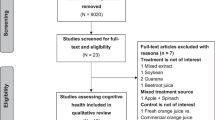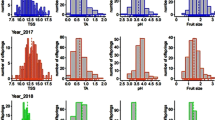Key Points
-
Reviews the current literature on fruit smoothies.
-
Evaluates the potential for fruit smoothies to bring about dental erosion.
-
Recommends that fruit smoothie consumption should be confined to mealtimes in order to minimise erosive risk.
Abstract
Introduction Recent health promotion campaigns have encouraged the public to consume at least five portions of fruit and vegetables per day. Many see consuming fruit smoothies as a way of achieving this.
Objective To ascertain the potential or otherwise for fruit smoothies to bring about dental erosion.
Design Laboratory study.
Method This was an in vitro investigation in which five varieties of shop bought fruit smoothies, including a 'thickie' were investigated, with respect to their initial pH, titratable acidity and effect upon exposure to the surface microhardness and profile of extracted human teeth. In addition their performance was compared to negative (Volvic™ water) and positive (orange juice) control drinks as well as a homemade smoothie, based upon the recipe of one of the commercially bought drinks, from which ingredient omissions were made.
Results The majority of the drinks investigated had a baseline pH below the critical pH of enamel (5.5) and required comparable volumes of 0.1M NaOH to raise their pH to neutrality as the positive control. Only two drinks (Volvic™ still mineral water, the negative control, and the yoghurt, vanilla bean and honey 'thickie') displayed a higher pH, though to neutralise the thickie, a lesser quantity of alkali addition was required. The immersion of the tooth samples in the drinks brought about reductions in their surface hardness (expressed as a percentage change of median hardness) but these were only significant (p <0.001) for the cranberry, blueberry and cherry fruit smoothie and homemade strawberry and banana fruit smoothie. There was no reduction in surface hardness in the case of the teeth immersed in the thickie. Omission of certain ingredients from the homemade smoothie affected the magnitude of surface hardness reductions seen. With regard to the loss of surface contour of the tooth samples following immersion in the drinks, as assessed by depth loss, there were significant differences between the drinks (p = 0.0064) with the thickie and negative control not causing depth loss and the kiwi, apple and lime smoothie producing most depth loss (28.26 (5.45) μm).
Conclusions Within the limitations of this study some fruit smoothies have the potential to bring about dental erosion if consumed irresponsibly. This can be influenced by ingredient variations. In order to minimise the risk of developing dental erosion, without removing the claimed nutritional benefits of their consumption, their consumption should be confined to mealtimes.
Similar content being viewed by others
Log in or create a free account to read this content
Gain free access to this article, as well as selected content from this journal and more on nature.com
or
References
Pindborg J J . Pathology of the dental hard tissues. Copenhagen: Munksgaard, 1970.
Gandara B K, Truelove E L . Diagnosis and management of dental erosion. J Contemp Dent Pract 1999; 1: 16–23.
O'Sullivan E, Milosevic A, British Society of Paediatric Dentistry. UK National clinical guidelines in paediatric dentistry: diagnosis, prevention and management of dental erosion. Int J Paediatr Dent 2008; 18 (Suppl 1): 29–38.
Lussi A, Jaeggi T, Zero D . The role of diet in the aetiology of dental erosion. Caries Res 2004; 38 (Suppl 1): 34–44.
Lussi A, Jaeggi T, Jaeggi-Schärer S . Prediction of the erosive potential of some beverages. Caries Res 1995; 29: 349–354.
Al-Dlaigan Y H, Shaw L, Smith A . Dental erosion in a group of British 14-year-old school children. Part II: Influence of dietary intake. Br Dent J 2001; 190: 258–261.
Grobler S R, Senekal P J, Laubscher J A . In vitro demineralization of enamel by orange juice, apple juice, Pepsi Cola and Diet Pepsi Cola. Clin Prev Dent 1990; 12: 5–9.
West N X, Maxwell A, Hughes J A, Parker D M, Newcombe R G, Addy M . A method to measure clinical erosion: the effect of orange juice consumption on erosion of enamel. J Dent 1998; 26: 329–335.
NHS Choices. 5 a day: what counts? NHS, 2009. Online information available at http://www.nhs.uk/Livewell/5ADAY/Pages/Whatcounts.aspx (accessed December 2012).
British Nutrition Foundation. A Healthy Varied Diet. Cited 2013, Feb 12. Online information available at http://www.nutrition.org.uk/healthyliving/healthyeating/a-healthy-varied-diet?start=3
British Soft Drinks Association. Children's consumption of soft drinks. BSDA consumer research 2008. BSDA, 2008. Online report available at http://www.britishsoftdrinks.com/pdf/chidren's%20consumption%20of %20soft%20drinks%20(high%20res).pdf (accessed December 2012).
Mercer C . Smoothie operators lead UK health binge. Beveragedaily.com 2007. Online article available at http://www.beveragedaily.com/Markets/Smoothie-operators-lead-UK-health-binge (accessed December 2012).
The Juice and Smoothie Association. Smoothie history. JASA, 2000. Online article available at http://www.smoothiecentral.com/Flashsite/index.html (accessed December 2008).
Innocent. The basics. What is a smoothie? Online information available at http://www.innocentdrinksforhcps.com/research.php (accessed December 2012).
Hughes J A, West N X, Parker D M, van den Braak M H, Addy M . Effects of pH and concentration of citric, malic and lactic acids on enamel, in vitro. J Dent 2000; 28: 147–152.
Mayes A . The dictionary of nutritional health. A guide to the relation between diet and health. UK: Thorsons Publishers Ltd, 1986.
Lussi A, Jäggi T, Schärer S . The influence of different factors on in vitro enamel erosion. Caries Res 1993; 27: 387–393.
British Soft Drinks Association. A changing climate. The 2008 UK soft drinks report. London: BSDA, 2008. Online report available at http://www.britishsoftdrinks.com/pdf/2008%20statistics%20report%20 low%20res.pdf (accessed December 2012).
Edwards M, Creanor S L, Foye R H, Gilmour W H . Buffering capacities of soft drinks: the potential influence on dental erosion. J Oral Rehabil 1999; 26: 923–927.
Blacker S M, Creanor S L, Creanor S . An in vitro investigation of the initial pH and titratable acidity of a selection of fruit smoothies. Dent Update 2011; 38: 604–606, 608–609.
Rees J, Loyn T, Gilmour A . Does low acid orange juice equal low erosion? Dent Update 2006; 33: 242–244.
Shellis R P, Finke M, Eisenberger M, Parker D M, Addy M . Relationship between enamel erosion and liquid flow rate. Eur J Oral Sci 2005; 113: 232–238.
Syed J, Chadwick R G . A laboratory investigation of consumer addition of UHT milk to lessen the erosive potential of fizzy drinks. Br Dent J 2009; 206: E6.
Rees J S . The role of drinks in tooth surface loss. Dent Update 2004; 31: 318–320, 322–324, 326.
Grobler S R, Senekal P J, Kotze T J . The degree of enamel erosion by five different kinds of fruit. Clin Prev Dent 1989; 11: 23–28.
Bassiouny M A, Yang J, Kuroda S . Topographie and radiographic profile assessment of dental erosion. Part II: effect of citrus fruit juices on human dentition. Gen Dent 2008; 56: 136–143.
Barbour M E, Finke M, Parker D M, Hughes J A, Allen G C, Addy M . The relationship between enamel softening and erosion caused by soft drinks at a range of temperatures. J Dent 2006; 34: 207–213.
Ehlen L A, Marshall T A, Qian F, Wefel J S, Warren J J . Acidic beverages increase the risk of in vitro tooth erosion. Nut Res 2008; 28: 299–303.
Amaechi B T, Higham S M, Edgar W M . Factors influencing the development of dental erosion in vitro: enamel type, temperature and exposure time. J Oral Rehabil 1999; 26: 624–630.
Bamise C T, Bamise O F . Quantifying the acidic content of commercial yoghurt drinks in Nigeria. Internet J Dent Sci 2008; 6: DOI: 10.5580/14ff. Online article available at http://www.ispub.com/journal/the_internet_journal_of_dental_science /volume_6_number_1_7/article/quantifying_the_acidic_content_of _commercial_yoghurt_drinks_in_nigeria.html (accessed December 2012).
Touyz L Z . Fruit induced sensitivity of cervical margins. J Dent Assoc S Afr 1983; 38: 199–200.
Larsen M J, Nyvad B . Enamel erosion by some soft drinks and orange juices relative to their pH, buffering effect and contents of calcium phosphate. Caries Res 1999; 33: 81–87.
Hui Y H, Barta J, Pilar Cano M, Gusek T W, Sidhu J S, Sinha N K . Handbook of fruits and fruit processing. Oxford: Wiley-Blackwell, 2006.
Lussi A . Dental erosion: from diagnosis to therapy. Monographs in Oral Science. Basel: Karger Publishers, 2006.
Barbour M E, Lussi A, Shellis R P . Screening and prediction of erosive potential. Caries Res 2011; 45 (Suppl 1): 24–32.
Barbour M E, Rees J S . The laboratory assessment of enamel erosion: a review. J Dent 2004; 32: 591–602.
West N X, Davies M, Amaechi B T . In vitro and in situ erosion models for evaluating tooth substance loss. Caries Res 2011; 45 (Suppl 1): 43–52.
Attin T . Methods for assessment of dental erosion. Monogr Oral Sci 2006; 20: 152–172.
Lussi A, Kohler N, Zero D, Schaffner M, Megert B . A comparison of the erosive potential of different beverages in primary and permanent teeth using an in vitro model. Eur J Oral Sci 2000; 108: 110–114.
Chu C H, Lo E C . Microhardness of dentine in primary teeth after topical fluoride applications. J Dent 2008; 36: 387–391.
Mahoney E K, Kilpatrick N M, Swain M V . Behaviour of primary incisor caries: a micromechanical study. Int J Paediatr Dent 2006; 16: 270–277.
Costa C C, Almeida I C, Costa Filho L C . Erosive effect of an antihistamine-containing syrup on primary enamel and its reduction by fluoride dentifrice. Int J Paediatr Dent 2006; 16: 174–180.
Basting R T, Rodrigues A L Jr, Serra M C . The effect of 10% carbamide peroxide, carbopol and/or glycerin on enamel and dentin microhardness. Oper Dent 2005; 30: 608–616.
Gedalia I, Dakuar A, Shapira L, Lewinstein I, Goultschin J, Rahamim E . Enamel softening with Coca-Cola and rehardening with milk or saliva. Am J Dent 1991; 4: 120–122.
NHS Choices. Sugars. NHS, 2011. Online information available at http://www.nhs.uk/Livewell/Goodfood/Pages/sugars.aspx (accessed December 2012).
British Heart Foundation. Heathy eating on a budget. BHF, 2011. Online article available at http://www.bhf.org.uk/heart-health/prevention/healthy-eating/healthy-eating-on-a-budget.aspx (accessed December 2012).
British Nutrition Foundation. Healthy snacking - choosing snacks. BNF, 2011. Online article available at http://www.nutrition.org.uk/healthyliving/healthyeating/healthy-snacking?start=1 (accessed December 2012).
Innocent. Are you getting enough? The barriers to getting your 5-a-day and how to help your patients get there. London: Innocent, 2010. Online article available at http://www.innocentdrinksforhcps.com/docs/innocent_5aday_report.pdf (accessed December 2012).
Dixey R, Heindl I, Loureiro I, Pérez-Rodrigo C, Snel J, Warnking P . Healthy eating for young people in Europe. A school based nutrition guide. European Network of Health Promoting Schools, 1999. Online article available at http://ws10.e-vision.nl/she_network/upload/pubs/HealthyeatingforyoungpeopleinEurope.pdf (accessed December 2012).
The Scottish Government. Healthy Eating in Schools: a guide to implementing the nutritional requirements for food and drink in schools (Scotland) regulations 2008. Edinburgh: The Scottish Government, 2008. Online article available at http://www.scotland.gov.uk/Publications/2008/09/12090355/0 (accessed December 2012).
Acknowledgements
The authors are grateful to the Oral and Dental Research Trust for funding this work through a Glaxo SmithKline project grant.
Author information
Authors and Affiliations
Corresponding author
Additional information
Refereed paper
Rights and permissions
About this article
Cite this article
Blacker, S., Chadwick, R. An in vitro investigation of the erosive potential of smoothies. Br Dent J 214, E9 (2013). https://doi.org/10.1038/sj.bdj.2013.164
Accepted:
Published:
Issue date:
DOI: https://doi.org/10.1038/sj.bdj.2013.164
This article is cited by
-
The effects of fruit smoothies on enamel erosion
European Archives of Paediatric Dentistry (2014)



